HP EliteBook 8770w User Manual

User Guide
© Copyright 2012, 2013 Hewlett-Packard
Development Company, L.P.
Bluetooth is a trademark owned by its proprietor and used by Hewlett-Packard Company under license. Intel is a trademark of Intel Corporation in the U.S. and other countries. AMD is a trademark of Advanced Micro Devices, Inc. SD Logo is a trademark of its proprietor. Java is a U.S. trademark of Sun Microsystems, Inc. Microsoft and Windows are U.S. registered trademarks of Microsoft Corporation.
The information contained herein is subject to change without notice. The only warranties for HP products and services are set forth in the express warranty statements accompanying such products and services. Nothing herein should be construed as constituting an additional warranty. HP shall not be liable for technical or editorial errors or omissions contained herein.
Second Edition: June 2013
First Edition: October 2012
Document Part Number: 697791-002
Product notice
This user guide describes features that are common to most models. Some features may not be available on your computer.
To obtain the latest information in this guide, contact support. For U.S. support, go to http://www.hp.com/go/contactHP. For worldwide support, go to http://welcome.hp.com/country/us/en/ wwcontact_us.html.
Software terms
By installing, copying, downloading, or otherwise using any software product preinstalled on this computer, you agree to be bound by the terms of the HP End User License Agreement (EULA). If you do not accept these license terms, your sole remedy is to return the entire unused product (hardware and software) within 14 days for a refund subject to the refund policy of your place of purchase.
For any further information or to request a full refund of the computer, please contact your local point of sale (the seller).

Safety warning notice
WARNING! To reduce the possibility of heat-related injuries or of overheating the computer, do not place the computer directly on your lap or obstruct the computer air vents. Use the computer only on a hard, flat surface. Do not allow another hard surface, such as an adjoining optional printer, or a soft surface, such as pillows or rugs or clothing, to block airflow. Also, do not allow the AC adapter to contact the skin or a soft surface, such as pillows or rugs or clothing, during operation. The computer and the AC adapter comply with the user-accessible surface temperature limits defined by the International Standard for Safety of Information Technology Equipment (IEC 60950).
iii
iv Safety warning notice

Table of contents
1 Welcome .......................................................................................................................................................... |
1 |
Finding information ............................................................................................................................... |
2 |
2 Getting to know your computer ..................................................................................................................... |
4 |
Top ....................................................................................................................................................... |
4 |
TouchPad ............................................................................................................................ |
4 |
Lights ................................................................................................................................... |
5 |
Buttons and fingerprint reader ............................................................................................. |
6 |
Keys ..................................................................................................................................... |
7 |
Front ..................................................................................................................................................... |
8 |
Right ..................................................................................................................................................... |
9 |
Left ..................................................................................................................................................... |
10 |
Rear .................................................................................................................................................... |
11 |
Display ................................................................................................................................................ |
12 |
Bottom ................................................................................................................................................ |
13 |
3 Connecting to a network .............................................................................................................................. |
15 |
Connecting to a wireless network ....................................................................................................... |
15 |
Using the wireless controls ................................................................................................ |
15 |
Using the wireless button .................................................................................. |
15 |
Using operating system controls ....................................................................... |
16 |
Using a WLAN ................................................................................................................... |
16 |
Using an Internet service provider .................................................................... |
16 |
Setting up a WLAN ............................................................................................ |
17 |
Configuring a wireless router ............................................................................ |
17 |
Protecting your WLAN ....................................................................................... |
17 |
Connecting to a WLAN ...................................................................................... |
18 |
Using HP Mobile Broadband (select models only) ............................................................ |
18 |
Inserting and removing a SIM ........................................................................... |
19 |
Using GPS (select models only) ........................................................................................ |
20 |
Using Bluetooth wireless devices ...................................................................................... |
20 |
Connecting to a wired network ........................................................................................................... |
20 |
Connecting to a local area network (LAN) ......................................................................... |
20 |
Using a modem .................................................................................................................. |
21 |
Connecting a modem cable .............................................................................. |
21 |
Connecting a countryor region-specific modem cable adapter ....................... |
22 |
v
4 Navigating using the keyboard, touch gestures and pointing devices ................................................... |
23 |
Using pointing devices ....................................................................................................................... |
23 |
Setting pointing device preferences ................................................................................... |
23 |
Using the pointing stick ...................................................................................................... |
23 |
Using the TouchPad .......................................................................................................... |
23 |
Turning the TouchPad off and on ...................................................................... |
24 |
Using TouchPad gestures ................................................................................. |
24 |
Tapping ............................................................................................. |
25 |
Scrolling ............................................................................................ |
25 |
Pinching/zooming ............................................................................. |
26 |
Rotating (select models only) ........................................................... |
26 |
2-finger click (select models only) .................................................... |
27 |
Flicking (select models only) ............................................................ |
27 |
Edge swipes (select models only) ..................................................................................... |
27 |
Right-edge swipe .............................................................................................. |
28 |
Top-edge swipe ................................................................................................. |
28 |
Left-edge swipe ................................................................................................. |
29 |
Using the keyboard ............................................................................................................................ |
29 |
Using Microsoft Windows 8 shortcut keys ......................................................................... |
30 |
Identifying the hot keys ...................................................................................................... |
31 |
Using keypads ................................................................................................................... |
33 |
Using the integrated numeric keypad ................................................................ |
33 |
Using an optional external numeric keypad ...................................................... |
33 |
5 Multimedia ..................................................................................................................................................... |
34 |
Using the media activity controls ........................................................................................................ |
34 |
Audio .................................................................................................................................................. |
34 |
Connecting speakers ......................................................................................................... |
34 |
Connecting headphones .................................................................................................... |
34 |
Connecting a microphone .................................................................................................. |
34 |
Adjusting the volume ......................................................................................................... |
35 |
Checking audio functions on the computer ........................................................................ |
35 |
Webcam (select models only) ............................................................................................................ |
36 |
Video .................................................................................................................................................. |
36 |
VGA ................................................................................................................................... |
37 |
DisplayPort (select models only) ....................................................................................... |
38 |
Intel Wireless Display (select models only) ....................................................................... |
39 |
6 Power management ...................................................................................................................................... |
40 |
Shutting down the computer ............................................................................................................... |
40 |
vi
Setting power options ......................................................................................................................... |
40 |
Using power-saving states ................................................................................................. |
40 |
Intel Rapid Start Technology (select models only) ............................................ |
41 |
Initiating and exiting Sleep ................................................................................ |
41 |
Enabling and exiting user-initiated Hibernation ................................................. |
41 |
Setting password protection on wakeup ........................................................... |
42 |
Using the power meter and power settings ....................................................... |
42 |
Using battery power ........................................................................................................... |
42 |
Finding additional battery information ............................................................... |
43 |
Using Battery Check ......................................................................................... |
43 |
Displaying the remaining battery charge ........................................................... |
43 |
Maximizing battery discharge time .................................................................... |
43 |
Managing low battery levels .............................................................................. |
43 |
Identifying low battery levels ............................................................. |
44 |
Resolving a low battery level ............................................................ |
44 |
Inserting or removing the battery ...................................................................... |
44 |
Inserting a battery ............................................................................. |
44 |
Removing a battery .......................................................................... |
45 |
Conserving battery power ................................................................................. |
46 |
Storing a user-replaceable battery (select models only) ................................... |
46 |
Disposing of a user-replaceable battery (select models only) ........................... |
46 |
Replacing a user-replaceable battery (select models only) .............................. |
46 |
Using external AC power ................................................................................................... |
46 |
Testing an AC adapter ...................................................................................... |
47 |
7 External cards and devices .......................................................................................................................... |
48 |
Using Media Card Reader cards (select models only) ....................................................................... |
48 |
Inserting a digital card ........................................................................................................ |
48 |
Removing a digital card ..................................................................................................... |
48 |
Using ExpressCards (select models only) .......................................................................................... |
49 |
Configuring an ExpressCard .............................................................................................. |
49 |
Inserting an ExpressCard .................................................................................................. |
50 |
Removing an ExpressCard ................................................................................................ |
51 |
Using smart cards (select models only) ............................................................................................. |
51 |
Inserting a smart card ........................................................................................................ |
52 |
Removing a smart card ...................................................................................................... |
52 |
Using a USB device ........................................................................................................................... |
52 |
Connecting a USB device .................................................................................................. |
53 |
Removing a USB device .................................................................................................... |
53 |
Using 1394 devices (select models only) ........................................................................................... |
53 |
Connecting a 1394 device ................................................................................................. |
54 |
vii
Removing a 1394 device ................................................................................................... |
54 |
Using an eSATA device (select models only) .................................................................................... |
54 |
Connecting an eSATA device ............................................................................................ |
55 |
Removing an eSATA device .............................................................................................. |
55 |
8 Drives ............................................................................................................................................................. |
56 |
Handling drives ................................................................................................................................... |
56 |
Using hard drives ............................................................................................................................... |
56 |
Intel Smart Response Technology (select models only) .................................................... |
57 |
Removing or replacing the service door ............................................................................ |
57 |
Removing the service door ............................................................................... |
57 |
Replacing the service door ................................................................................ |
58 |
Replacing or upgrading the hard drive ............................................................................... |
59 |
Removing the primary hard drive ...................................................................... |
59 |
Removing the secondary hard drive ................................................................. |
60 |
Installing the primary hard drive ........................................................................ |
61 |
Installing the secondary hard drive ................................................................... |
63 |
Replacing a drive in the upgrade bay ................................................................................ |
63 |
Replacing a hard drive ...................................................................................... |
64 |
Replacing an optical drive ................................................................................. |
66 |
Improving hard drive performance ..................................................................................... |
68 |
Using Disk Defragmenter .................................................................................. |
68 |
Using Disk Cleanup ........................................................................................... |
68 |
Using HP 3D DriveGuard (select models only) .................................................................. |
68 |
Identifying HP 3D DriveGuard status ................................................................ |
69 |
Managing power with a parked hard drive ........................................................ |
69 |
Using HP 3D DriveGuard software ................................................................... |
69 |
Using optical drives (select models only) ........................................................................................... |
70 |
Identifying the installed optical drive .................................................................................. |
70 |
Inserting an optical disc ..................................................................................................... |
71 |
Tray-load ........................................................................................................... |
71 |
Removing an optical disc ................................................................................................... |
72 |
Tray-load ........................................................................................................... |
72 |
When the disc tray opens normally .................................................. |
72 |
When the disc tray fails to open normally ......................................... |
72 |
Sharing optical drives ........................................................................................................ |
74 |
Using RAID (select models only) ........................................................................................................ |
74 |
9 Security .......................................................................................................................................................... |
75 |
Protecting the computer ..................................................................................................................... |
75 |
Using passwords ................................................................................................................................ |
76 |
viii
Setting passwords in Windows .......................................................................................... |
76 |
Setting passwords in Computer Setup .............................................................................. |
77 |
Managing a BIOS administrator password ........................................................................ |
77 |
Entering a BIOS administrator password .......................................................... |
79 |
Managing a Computer Setup DriveLock password ........................................................... |
79 |
Setting a DriveLock password ........................................................................... |
79 |
Entering a DriveLock password ........................................................................ |
80 |
Changing a DriveLock password ...................................................................... |
80 |
Removing DriveLock protection ........................................................................ |
80 |
Using Computer Setup Automatic DriveLock .................................................................... |
81 |
Entering an Automatic DriveLock password ..................................................... |
81 |
Removing Automatic DriveLock protection ....................................................... |
81 |
Using antivirus software ..................................................................................................................... |
82 |
Using firewall software ....................................................................................................................... |
82 |
Installing critical security updates ....................................................................................................... |
83 |
Using HP ProtectTools Security Manager (select models only) ......................................................... |
83 |
Installing an optional security cable .................................................................................................... |
83 |
Using the fingerprint reader (select models only) ............................................................................... |
84 |
Locating the fingerprint reader ........................................................................................... |
84 |
10 Maintenance ................................................................................................................................................ |
85 |
Adding or replacing memory modules ................................................................................................ |
85 |
Adding or replacing the memory module underneath the service door ............................. |
85 |
Adding or replacing the memory module underneath the keyboard .................................. |
87 |
Cleaning your computer ..................................................................................................................... |
92 |
Cleaning products .............................................................................................................. |
92 |
Cleaning procedures .......................................................................................................... |
92 |
Cleaning the display .......................................................................................... |
92 |
Cleaning the sides and cover ............................................................................ |
92 |
Cleaning the TouchPad and keyboard .............................................................. |
92 |
Updating programs and drivers .......................................................................................................... |
93 |
Using SoftPaq Download Manager .................................................................................................... |
93 |
11 Backup and recovery .................................................................................................................................. |
94 |
Backing up your information ............................................................................................................... |
94 |
Performing a system recovery ............................................................................................................ |
95 |
Using the Windows recovery tools ..................................................................................... |
95 |
Using f11 recovery tools .................................................................................................... |
96 |
Using Windows 8 operating system media (purchased separately) .................................. |
96 |
Using Windows Refresh for quick and easy recovery ....................................................... |
97 |
Remove everything and reinstall Windows ........................................................................ |
97 |
ix
Using HP Software Setup .................................................................................................. |
98 |
12 Computer Setup (BIOS) and Advanced System Diagnostics ................................................................. |
99 |
Using Computer Setup ....................................................................................................................... |
99 |
Starting Computer Setup ................................................................................................... |
99 |
Navigating and selecting in Computer Setup ..................................................................... |
99 |
Restoring factory settings in Computer Setup ................................................................. |
100 |
Updating the BIOS ........................................................................................................... |
100 |
Determining the BIOS version ......................................................................... |
101 |
Downloading a BIOS update ........................................................................... |
101 |
Using Advanced System Diagnostics ............................................................................................... |
102 |
13 Support ...................................................................................................................................................... |
103 |
Contacting support ........................................................................................................................... |
103 |
Labels ............................................................................................................................................... |
104 |
14 Specifications ............................................................................................................................................ |
105 |
Input power ....................................................................................................................................... |
105 |
Operating environment ..................................................................................................................... |
105 |
Appendix A Traveling with the computer .................................................................................................... |
106 |
Appendix B Troubleshooting ........................................................................................................................ |
107 |
Troubleshooting resources ............................................................................................................... |
107 |
Resolving issues .............................................................................................................................. |
107 |
The computer is unable to start up .................................................................................. |
107 |
The computer screen is blank .......................................................................................... |
108 |
Software is functioning abnormally .................................................................................. |
108 |
The computer is on but not responding ........................................................................... |
108 |
The computer is unusually warm ..................................................................................... |
108 |
An external device is not working .................................................................................... |
109 |
The wireless network connection is not working .............................................................. |
109 |
The optical disc tray does not open for removal of a CD or DVD .................................... |
109 |
The computer does not detect the optical drive ............................................................... |
110 |
A disc does not play ......................................................................................................... |
110 |
A movie is not visible on an external display ................................................................... |
111 |
The process of burning a disc does not begin, or it stops before completion .................. |
111 |
Appendix C Electrostatic discharge ............................................................................................................ |
112 |
x
Index ................................................................................................................................................................. |
113 |
xi
xii

1 Welcome
After you set up and register the computer, it is important to take the following steps:
●Take a minute to browse the printed Windows 8 Basics guide to explore the new Windows® features.

 TIP: To quickly return to the computer Start screen from an open app or the Windows desktop,
TIP: To quickly return to the computer Start screen from an open app or the Windows desktop,  press the Windows logo key
press the Windows logo key  on your keyboard. Pressing the Windows logo key again will return you to the previous screen.
on your keyboard. Pressing the Windows logo key again will return you to the previous screen.
●Connect to the Internet—Set up your wired or wireless network so that you can connect to the Internet. For more information, see Connecting to a network on page 15.
●Update your antivirus software—Protect your computer from damage caused by viruses. The software is preinstalled on the computer. For more information, see Using antivirus software on page 82.
●Get to know your computer—Learn about your computer features. See Getting to know your computer on page 4 and Navigating using the keyboard, touch gestures and pointing devices on page 23 for additional information.
●Find installed software—Access a list of the software preinstalled on the computer:
From the Start screen, type a, click Apps, and then select from the displayed options. For details about using the software included with the computer, see the software manufacturer's instructions, which may be provided with the software or on the manufacturer's website.
●Back up your hard drive—Create recovery discs or a recovery flash drive. See Backup and recovery on page 94.
1

Finding information
The computer comes with several resources to help you perform various tasks.
Resources |
For information about |
|
|
|
|
Setup Instructions poster |
● How to set up the computer |
|
|
● Help to identify computer components |
|
|
|
|
Windows 8 Basics guide |
Overview of using and navigating with Windows® 8. |
|
|
|
|
Help and Support |
● |
Operating system information |
To access Help and Support, type h, and then select |
● Software, driver, and BIOS updates |
|
Help and Support. |
● |
Troubleshooting tools |
|
||
To obtain the latest information in this guide, contact |
● How to access support |
|
support. For U.S. support, go to http://www.hp.com/go/ |
||
contactHP. For worldwide support, go to |
|
|
http://welcome.hp.com/country/us/en/ |
|
|
wwcontact_us.html. |
|
|
|
|
|
Regulatory, Safety, and Environmental Notices |
● Regulatory and safety information |
|
To access this guide, from the Start screen, select the |
● |
Battery disposal information |
HP Support Assistant app, select My computer, and |
|
|
then select User guides. |
|
|
|
|
|
Safety & Comfort Guide |
● Proper workstation setup, posture, health, and work habits |
|
To access this guide, from the Start screen, select the |
● Electrical and mechanical safety information |
|
HP Support Assistant app, select My computer, and |
|
|
then select User guides. |
|
|
– or – |
|
|
Go to http://www.hp.com/ergo. |
|
|
|
|
|
Worldwide Telephone Numbers booklet |
HP support telephone numbers |
|
This booklet is provided with your computer. |
|
|
HP website
To obtain the latest information in this guide, contact support. For U.S. support, go to http://www.hp.com/go/ contactHP. For worldwide support, go to http://welcome.hp.com/country/us/en/ wwcontact_us.html.
●Support information
●Ordering parts and finding additional help
●Accessories available for the device
2 Chapter 1 Welcome

Resources |
For information about |
|
|
Limited Warranty* |
Warranty information |
To access this guide, from the Start screen, select the |
|
HP Support Assistant app, select My computer, and |
|
then select Warranty and services. |
|
– or – |
|
Go to http://www.hp.com/go/orderdocuments. |
|
*You can find the expressly provided HP Limited Warranty applicable to your product located with the user guides on your computer and/or on the CD/DVD provided in the box. In some countries/regions, HP may provide a printed HP Limited Warranty in the box. For some countries/regions where the warranty is not provided in printed format, you may request a printed copy from http://www.hp.com/go/orderdocuments or write to:
●North America: Hewlett-Packard, MS POD, 11311 Chinden Blvd., Boise, ID 83714, USA
●Europe, Middle East, Africa: Hewlett-Packard, POD, Via G. Di Vittorio, 9, 20063, Cernusco s/Naviglio (MI), Italy
●Asia Pacific: Hewlett-Packard, POD, P.O. Box 200, Alexandra Post Office, Singapore 911507
When you request a printed copy of your warranty, please include your product number, warranty period (found on your service label), name, and postal address.
IMPORTANT: Do NOT return your HP product to the addresses above. For U.S. support, go to http://www.hp.com/go/ contactHP. For worldwide support, go to http://welcome.hp.com/country/us/en/wwcontact_us.html.
Finding information |
3 |

2 Getting to know your computer
Top
TouchPad
Component |
|
Description |
|
|
|
(1) |
Left pointing stick button |
Functions like the left button on an external mouse. |
|
|
|
(2) |
Center pointing stick button |
Functions like the center button on an external mouse. |
|
|
|
(3) |
Pointing stick |
Moves the pointer and selects or activates items on the |
|
|
screen. |
|
|
|
(4) |
Right pointing stick button |
Functions like the right button on an external mouse. |
|
|
|
(5) |
Right TouchPad button |
Functions like the right button on an external mouse. |
|
|
|
(6) |
Center TouchPad button |
Functions like the center button on an external mouse. |
|
|
|
(7) |
Left TouchPad button |
Functions like the left button on an external mouse. |
|
|
|
(8) |
TouchPad zone |
Moves the pointer and selects or activates items on the |
|
|
screen. |
|
|
|
(9) |
TouchPad on/off button |
Turns the TouchPad on and off. |
|
|
|
4 |
Chapter 2 Getting to know your computer |
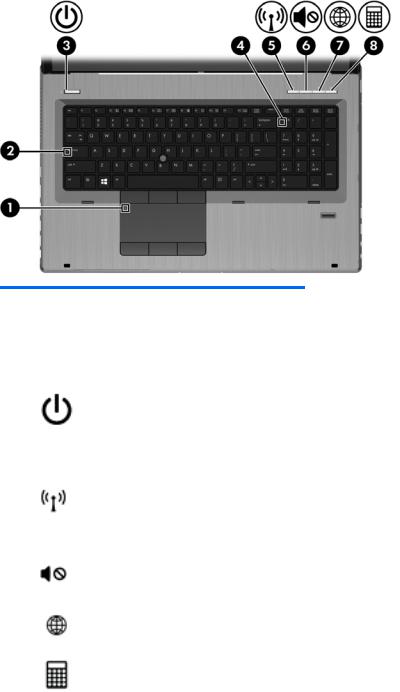
Lights
Component |
|
Description |
|
|
|
(1) |
TouchPad light |
● Amber: The TouchPad is off. |
|
|
● Off: The TouchPad is on. |
|
|
|
(2) |
Caps lock light |
On: Caps lock is on. |
|
|
|
(3) |
Power light |
● On: The computer is on. |
|
|
● Blinking: The computer is in the Sleep state. |
|
|
● Off: The computer is off. |
|
|
|
(4) |
Num lock light |
On: Num lock is on. |
|
|
|
(5) |
Wireless light |
● White: An integrated wireless device, such as a |
|
|
wireless local area network (WLAN) device and/or a |
|
|
Bluetooth® device, is on. |
|
|
● Amber: All wireless devices are off. |
|
|
|
(6) |
Mute light |
● Amber: Computer sound is off. |
|
|
● Off: Computer sound is on. |
|
|
|
(7) |
Web browser light |
● On: The computer is on. |
|
|
● Off: The computer is off. |
|
|
|
(8) |
Calculator light |
● On: The calculator function is on. |
|
|
● Blinking: The calculator has been activated. |
|
|
|
Top 5

Buttons and fingerprint reader
Component |
|
Description |
|
|
|
(1) |
TouchPad on/off button |
Turns the TouchPad on and off. |
|
|
|
(2) |
Power button |
● When the computer is off, press the button to turn on |
|
|
the computer. |
|
|
● When the computer is in the Sleep state, press the |
|
|
button briefly to exit Sleep. |
|
|
● When the computer is in Hibernation, press the button |
|
|
briefly to exit Hibernation. |
|
|
CAUTION: Pressing and holding down the power button |
|
|
will result in the loss of unsaved information. |
|
|
If the computer has stopped responding and Windows® |
|
|
shutdown procedures are ineffective, press and hold the |
|
|
power button for at least 5 seconds to turn off the computer. |
|
|
To learn more about your power settings, see your power |
|
|
options. From the Start screen, type power, select |
|
|
Settings, and then select Power Options. |
|
|
|
(3) |
Wireless button |
Turns the wireless feature on or off but does not establish a |
|
|
wireless connection. |
|
|
|
(4) |
Volume mute button |
Mutes and restores speaker sound. |
|
|
|
(5) |
Web browser button |
Opens the default Web browser. |
|
|
|
(6) |
Calculator button |
Opens the calculator function. |
|
|
|
(7) |
Fingerprint reader |
Allows a fingerprint logon to Windows, instead of a |
|
|
password logon. |
|
|
|
6 |
Chapter 2 Getting to know your computer |
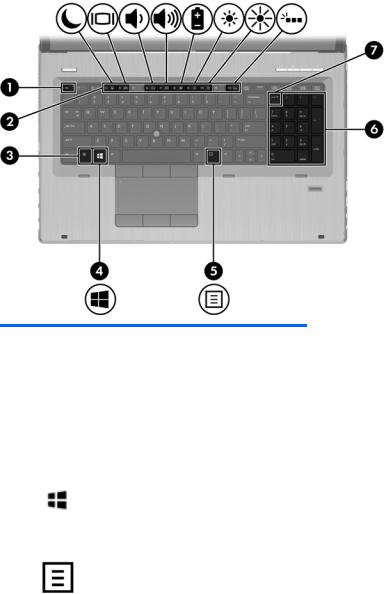
Keys
Component |
|
Description |
|
|
|
(1) |
esc key |
Displays system information when pressed in combination |
|
|
with the fn key. |
|
|
|
(2) |
Function keys |
Execute frequently used system functions when pressed in |
|
|
combination with the fn key. |
|
|
|
(3) |
fn key |
Executes frequently used system functions when pressed |
|
|
in combination with a function key, the num lk key, or the |
|
|
esc key. |
|
|
|
(4) |
Windows logo key |
Returns you to the Start screen from an open app or the |
|
|
Windows desktop. |
|
|
NOTE: Pressing the Windows logo key again will return |
|
|
you to the previous screen. |
|
|
|
(5) |
Windows apps key |
Displays options for a selected object. |
|
|
|
(6) |
Integrated numeric keypad |
When num lk has been enabled, it can be used like an |
|
|
external numeric keypad. |
|
|
|
(7) |
num lk key |
Alternates between the navigational and numeric functions |
|
|
on the integrated numeric keypad. |
|
|
|
Top 7

Front
Component |
|
Description |
|
|
|
(1) |
Media Card Reader |
Reads data from and writes data to digital memory |
|
|
cards such as Secure Digital (SD). |
|
|
|
(2) |
Display release latch |
Opens the computer. |
|
|
|
(3) |
Wireless light |
● White: An integrated wireless device, such as a |
|
|
wireless local area network (WLAN) device and/ |
|
|
or a Bluetooth® device, is on. |
|
|
● Amber: All wireless devices are off. |
|
|
|
(4) |
Power light |
● On: The computer is on. |
|
|
● Blinking: The computer is in the Sleep state. |
|
|
● Off: The computer is off. |
|
|
|
(5) |
AC adapter/Battery light |
● White: The computer is connected to external |
|
|
power and the battery is charged from 90 to 99 |
|
|
percent. |
|
|
● Amber: The computer is connected to external |
|
|
power and the battery is charged from 0 to 90 |
|
|
percent. |
|
|
● Blinking amber: A battery that is the only |
|
|
available power source has reached a low battery |
|
|
level. When the battery reaches a critical battery |
|
|
level, the battery light begins blinking rapidly. |
|
|
● Off: The battery is fully charged. |
|
|
|
(6) |
Hard drive light |
● Blinking white: The hard drive is being accessed. |
|
|
● Amber: HP 3D DriveGuard has temporarily |
|
|
parked the hard drive. |
|
|
|
(7) |
Speakers (2) |
Produce SRS Premium Sound or SRS Premium |
|
|
Sound PRO (select models only). |
NOTE: To use the SRS Premium Sound software, from the Start screen, type SRS, and then select SRS Premium Sound.
8 |
Chapter 2 Getting to know your computer |

Right
Component |
|
Description |
|
|
|
(1) |
Audio-out (headphone) jack |
Connects optional powered stereo speakers, headphones, |
|
|
earbuds, a headset, or a television audio cable. |
|
|
WARNING! To reduce the risk of personal injury, adjust |
|
|
the volume before putting on headphones, earbuds, or a |
|
|
headset. For additional safety information, see the |
|
|
Regulatory, Safety, and Environmental Notices. To access |
|
|
this guide, from the Start screen, select the HP Support |
|
|
Assistant app, select My computer, and then select User |
|
|
guides. |
|
|
NOTE: When a device is connected to the jack, the |
|
|
computer speakers are disabled. |
|
|
|
(2) |
Audio-in (microphone) jack |
Connects an optional computer headset microphone, |
|
|
stereo array microphone, or monaural microphone. |
|
|
|
(3) |
USB 2.0 charging port |
Connects an optional USB device. The USB charging port |
|
|
can also charge select models of cell phones and MP3 |
|
|
players, even when the computer is off. |
|
|
|
(4) |
USB 2.0 port |
Connects an optional USB device. |
|
|
|
(5) |
External monitor port |
Connects an external VGA monitor or projector. |
|
|
|
(6) |
Smart card reader |
Supports optional smart cards. |
|
|
|
(7) |
Upgrade bay (optical drive shown) |
The upgrade bay can hold either a hard drive or an optical |
|
|
drive that reads and writes (select models only) to an |
|
|
optical disc. It can also hold a weight saver option. |
|
|
|
(8) |
Optical drive eject button |
Releases the optical drive disc tray. |
|
|
|
Right 9
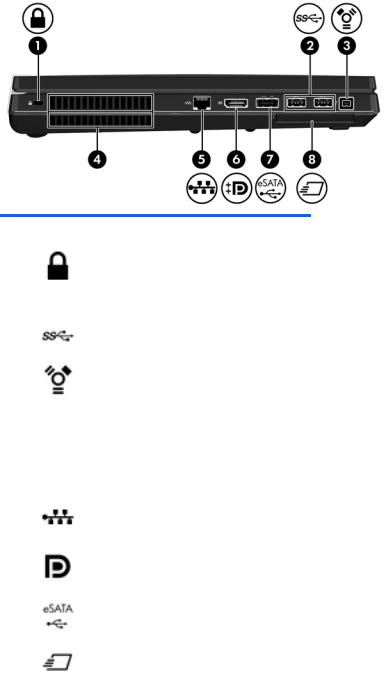
Left
Component |
|
Description |
|
|
|
(1) |
Security cable slot |
Attaches an optional security cable to the computer. |
|
|
NOTE: The security cable is designed to act as a |
|
|
deterrent, but it may not prevent the computer from being |
|
|
mishandled or stolen. |
|
|
|
(2) |
USB 3.0 ports (2) |
Connect optional USB 3.0 devices and provide enhanced |
|
|
USB power performance. |
|
|
|
(3) |
1394 port |
Connects an optional IEEE 1394 or 1394a device, such as |
|
|
a camcorder. |
|
|
|
(4) |
Vents (2) |
Enable airflow to cool internal components. |
|
|
NOTE: The computer fan starts up automatically to cool |
|
|
internal components and prevent overheating. It is normal |
|
|
for the internal fan to cycle on and off during routine |
|
|
operation. |
|
|
|
(5) |
RJ-45 (network) jack |
Connects a network cable. |
|
|
|
(6) |
DisplayPort |
Connects an optional digital display device, such as a |
|
|
high-performance monitor or projector. |
|
|
|
(7) |
eSATA/USB 2.0 combo port |
Connects an optional high-performance eSATA |
|
|
component, such as an eSATA external hard drive, or |
|
|
connects an optional USB device. |
|
|
|
(8) |
HP ExpressCard slot |
Supports optional ExpressCards. |
|
|
|
10 Chapter 2 Getting to know your computer
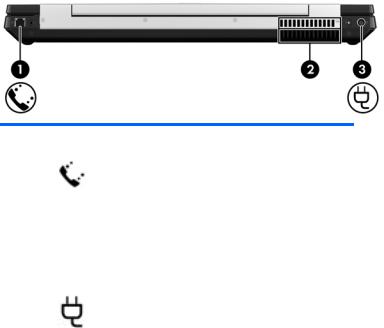
Rear
Component |
|
Description |
|
|
|
(1) |
RJ-11 (modem) jack |
Connects a modem cable. |
|
|
|
(2) |
Vents (2) |
Enable airflow to cool internal components. |
|
|
NOTE: The computer fan starts up |
|
|
automatically to cool internal components and |
|
|
prevent overheating. It is normal for the internal |
|
|
fan to cycle on and off during routine operation. |
|
|
|
(3) |
Power connector |
Connects an AC adapter. |
|
|
|
Rear 11
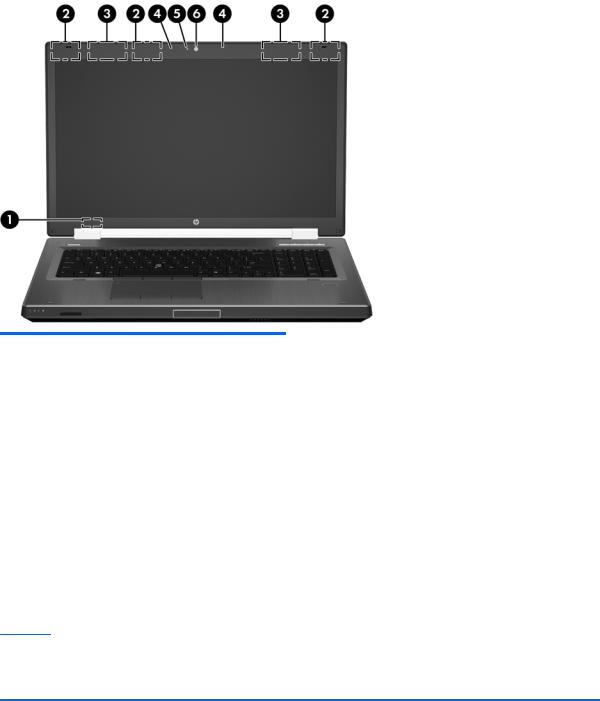
Display
Component |
Description |
|
|
|
|
(1) |
Internal display switch |
Turns off the display or initiates Sleep if the display is closed |
|
|
while the power is on. |
|
|
NOTE: The display switch is not visible from the outside of the |
|
|
computer. |
|
|
|
(2) |
WLAN antennas (3)* |
Send and receive wireless signals to communicate with wireless |
|
|
local area networks (WLAN). |
|
|
|
(3) |
WWAN antennas (2) |
Send and receive wireless signals to communicate with wireless |
|
|
wide area networks (WWAN). |
|
|
|
(4) |
Internal microphones (2) |
Record sound. |
|
|
|
(5) |
Webcam light |
On: The webcam is in use. |
|
|
|
(6) |
Webcam |
Records video and captures still photographs. |
|
|
For information on using the webcam, access Help and Support. |
|
|
From the Start screen, type h, and then select Help and |
|
|
Support. |
*The antennas are not visible from the outside of the computer. For optimal transmission, keep the areas immediately around the antennas free from obstructions. To see wireless regulatory notices, see the section of the Regulatory, Safety, and Environmental Notices that applies to your country or region. To access this guide, from the Start screen, select the HP Support Assistant app, select My computer, and then select User guides.
12 Chapter 2 Getting to know your computer

Bottom
Component |
|
Description |
|
|
|
(1) |
Battery bay |
Holds the battery. |
|
|
|
(2) |
SIM slot |
Supports a wireless subscriber identity module (SIM). |
|
|
The SIM slot is located inside the battery bay. |
|
|
|
(3) |
Battery release latch |
Releases the battery. |
|
|
|
(4) |
Accessory battery connector |
Connects an optional accessory battery. |
|
|
|
(5) |
Docking connector |
Connects an optional docking device. |
|
|
|
(6) |
Service door release latch |
Releases the service door on the computer. |
|
|
|
(7) |
Vents (3) |
Enable airflow to cool internal components. |
|
|
NOTE: The computer fan starts up automatically to |
|
|
cool internal components and prevent overheating. It is |
|
|
normal for the internal fan to cycle on and off during |
|
|
routine operation. |
|
|
|
(8) |
Bluetooth compartment |
Contains a Bluetooth device (select models only). |
|
|
|
Bottom 13
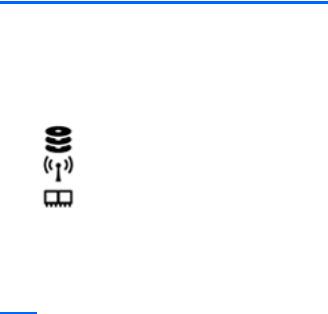
Component |
|
Description |
|
|
|
(9) |
Speakers (2) |
Produce SRS Premium Sound or SRS Premium Sound |
|
|
PRO (select models only). |
|
|
NOTE: To use the SRS Premium Sound software, |
|
|
from the Start screen, type SRS, and then select SRS |
|
|
Premium Sound. |
|
|
|
(10) |
Service door |
Provides access to the hard drive bay, the wireless |
|
|
LAN (WLAN) module slot, the WWAN module slot, and |
|
|
the memory module slots. |
NOTE: To prevent an unresponsive system, replace the wireless module only with a wireless module authorized for use in the computer by the governmental agency that regulates wireless devices in your country or region. If you replace the module and then receive a warning message, remove the module to restore computer functionality, and then contact technical support through Help and Support. From the Start screen, type h, and then select Help and Support.
14 Chapter 2 Getting to know your computer

3 Connecting to a network
Your computer can travel with you wherever you go. But even at home, you can explore the globe and access information from millions of websites using your computer and a wired or wireless network connection. This chapter will help you get connected to that world.
Connecting to a wireless network
Wireless technology transfers data across radio waves instead of wires. Your computer may be equipped with one or more of the following wireless devices:
●Wireless local area network (WLAN) device—Connects the computer to wireless local area networks (commonly referred to as Wi-Fi networks, wireless LANs, or WLANs) in corporate offices, your home, and public places such as airports, restaurants, coffee shops, hotels, and universities. In a WLAN, the mobile wireless device in your computer communicates with a wireless router or a wireless access point.
●HP Mobile Broadband Module (select models only)—A wireless wide area network (WWAN) device that gives you wireless connectivity over a much larger area. Mobile network operators install base stations (similar to cell phone towers) throughout large geographic areas, effectively providing coverage across entire states, regions, or even countries.
●Bluetooth device—Creates a personal area network (PAN) to connect to other Bluetoothenabled devices such as computers, phones, printers, headsets, speakers, and cameras. In a PAN, each device communicates directly with other devices, and devices must be relatively close together—typically within 10 meters (approximately 33 feet) of each other.
For more information about wireless technology, see the information and website links provided in Help and Support. From the Start screen, type h, and then select Help and Support.
Using the wireless controls
You can control the wireless devices in your computer using these features:
●Wireless button, wireless switch, or wireless key (referred to in this chapter as the wireless button)
●Operating system controls
Using the wireless button
The computer has a wireless button, one or more wireless devices, and one or two wireless lights, depending on the model. All of the wireless devices on your computer are enabled at the factory, so the wireless light is on (white) when you turn on the computer.
The wireless light indicates the overall power state of your wireless devices, not the status of individual devices. If the wireless light is white, at least one wireless device is on. If the wireless light is off, all wireless devices are off.
 NOTE: On some models, the wireless light is amber when all wireless devices are off.
NOTE: On some models, the wireless light is amber when all wireless devices are off.
Because the wireless devices are enabled at the factory, you can use the wireless button to turn on or turn off the wireless devices simultaneously.
Connecting to a wireless network 15

Using operating system controls
The Network and Sharing Center allows you to set up a connection or network, connect to a network, manage wireless networks, and diagnose and repair network problems.
To use operating system controls:
1.From the Start screen, type n, and then select Settings.
2.Type network and sharing in the search box, and then select Network and Sharing Center.
For more information, from the Start screen, type h, and then select Help and Support.
Using a WLAN
With a WLAN device, you can access a wireless local area network (WLAN), which is composed of other computers and accessories that are linked by a wireless router or a wireless access point.
 NOTE: The terms wireless router and wireless access point are often used interchangeably.
NOTE: The terms wireless router and wireless access point are often used interchangeably.
●A large-scale WLAN, such as a corporate or public WLAN, typically uses wireless access points that can accommodate a large number of computers and accessories and can separate critical network functions.
●A home or small office WLAN typically uses a wireless router, which allows several wireless and wired computers to share an Internet connection, a printer, and files without requiring additional pieces of hardware or software.
To use the WLAN device in your computer, you must connect to a WLAN infrastructure (provided through a service provider or a public or corporate network).
Using an Internet service provider
When you are setting up Internet access in your home, you must establish an account with an Internet service provider (ISP). To purchase Internet service and a modem, contact a local ISP. The ISP will help set up the modem, install a network cable to connect your wireless router to the modem, and test the Internet service.


 NOTE: Your ISP will give you a user ID and a password to use for Internet access. Record this information and store it in a safe place.
NOTE: Your ISP will give you a user ID and a password to use for Internet access. Record this information and store it in a safe place.
16 Chapter 3 Connecting to a network
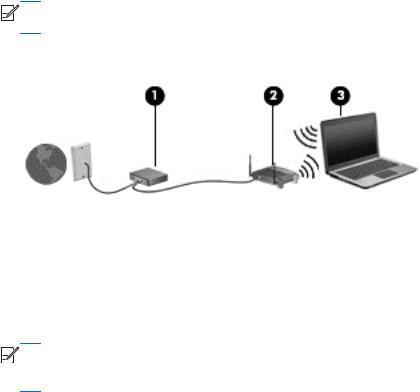
Setting up a WLAN
To set up a WLAN and connect to the Internet, you need the following equipment:
●A broadband modem (either DSL or cable) (1) and high-speed Internet service purchased from an Internet service provider
●A wireless router (2) (purchased separately)
●A wireless computer (3)


 NOTE: Some modems have a built-in wireless router. Check with your ISP to determine what type of modem you have.
NOTE: Some modems have a built-in wireless router. Check with your ISP to determine what type of modem you have.
The illustration below shows an example of a wireless network installation that is connected to the Internet.
As your network grows, additional wireless and wired computers can be connected to the network to access the Internet.
For help in setting up your WLAN, see the information provided by your router manufacturer or your ISP.
Configuring a wireless router
For help in setting up a WLAN, see the information provided by your router manufacturer or your ISP.


 NOTE: It is recommended that you initially connect your new wireless computer to the router by using the network cable provided with the router. When the computer successfully connects to the Internet, disconnect the cable, and access the Internet through your wireless network.
NOTE: It is recommended that you initially connect your new wireless computer to the router by using the network cable provided with the router. When the computer successfully connects to the Internet, disconnect the cable, and access the Internet through your wireless network.
Protecting your WLAN
When you set up a WLAN or access an existing WLAN, always enable security features to protect your network from unauthorized access. WLANs in public areas (hotspots) like coffee shops and airports may not provide any security. If you are concerned about the security of your computer when connected to a hotspot, limit your network activities to email that is not confidential and basic Internet surfing.
Wireless radio signals travel outside the network, so other WLAN devices can pick up unprotected signals. Take the following precautions to protect your WLAN:
●Use a firewall.
A firewall checks both data and requests for data that are sent to your network, and discards any suspicious items. Firewalls are available in both software and hardware. Some networks use a combination of both types.
●Use wireless encryption.
Wireless encryption uses security settings to encrypt and decrypt data that is transmitted over the network. For more information, from the Start screen, type h, and then select Help and Support.
Connecting to a wireless network 17

Connecting to a WLAN
To connect to the WLAN, follow these steps:
1.Be sure that the WLAN device is on. If the device is on, the wireless light is on. If the wireless light is off, press the wireless button.
 NOTE: On some models, the wireless light is amber when all wireless devices are off.
NOTE: On some models, the wireless light is amber when all wireless devices are off.
2.From the Windows desktop, tap or click the network status icon in the notification area, at the far right of the taskbar.
3.Select your WLAN from the list.
4.Click Connect.
If the WLAN is a security-enabled WLAN, you are prompted to enter a security code. Type the code, and then click OK to complete the connection.
 NOTE: If no WLANs are listed, you may be out of range of a wireless router or access point.
NOTE: If no WLANs are listed, you may be out of range of a wireless router or access point.


 NOTE: If you do not see the WLAN you want to connect to, from the Windows desktop, rightclick the network status icon, and then select Open Network and Sharing Center. Click Set up a new connection or network. A list of options is displayed, allowing you to manually search for and connect to a network or to create a new network connection.
NOTE: If you do not see the WLAN you want to connect to, from the Windows desktop, rightclick the network status icon, and then select Open Network and Sharing Center. Click Set up a new connection or network. A list of options is displayed, allowing you to manually search for and connect to a network or to create a new network connection.
After the connection is made, place the mouse pointer over the network status icon in the notification area, at the far right of the taskbar, to verify the name and status of the connection.


 NOTE: The functional range (how far your wireless signals travel) depends on WLAN implementation, router manufacturer, and interference from other electronic devices or structural barriers such as walls and floors.
NOTE: The functional range (how far your wireless signals travel) depends on WLAN implementation, router manufacturer, and interference from other electronic devices or structural barriers such as walls and floors.
Using HP Mobile Broadband (select models only)
HP Mobile Broadband enables your computer to use WWANs to access the Internet from more places and over larger areas than it can by using WLANs. Using HP Mobile Broadband requires a network service provider (called a mobile network operator), which in most cases is a cellular phone network operator. Coverage for HP Mobile Broadband is similar to cellular phone voice coverage.
When used with mobile network operator service, HP Mobile Broadband gives you the freedom to stay connected to the Internet, send email, or connect to your corporate network whether you are on the road or outside the range of Wi-Fi hotspots.
HP supports the following technologies:
●HSPA (High Speed Packet Access), which provides access to networks based on the Global System for Mobile Communications (GSM) telecommunications standard.
●EV-DO (Evolution Data Optimized), which provides access to networks based on the code division multiple access (CDMA) telecommunications standard.
You may need the HP Mobile Broadband Module serial number to activate mobile broadband service. The serial number is printed on a label inside the battery bay of your computer.
Some mobile network operators require the use of a SIM. A SIM contains basic information about you, such as a personal identification number (PIN), as well as network information. Some computers include a SIM that is preinstalled in the battery bay. If the SIM is not preinstalled, it may be provided in the HP Mobile Broadband information provided with your computer or the mobile network operator may provide it separately from the computer.
18 Chapter 3 Connecting to a network
